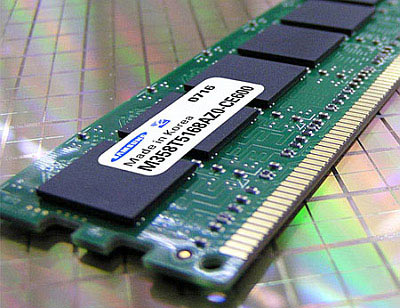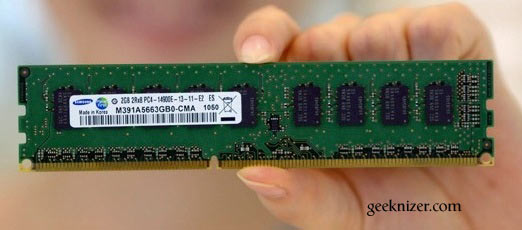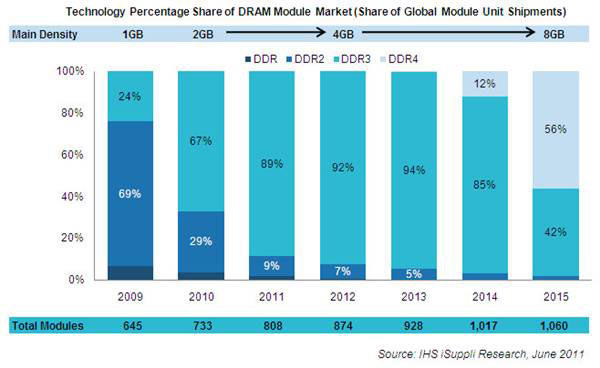Double data rate synchronous dynamic random-access memory 3 or simply put DDR3 has been playing the important role speeding up RAM speeds that were possible with DDR2 RAM. Well, things are again doubling, and that too at a lower power consumption.
The JEDEC Solid State Technology Association has published the specifications for the next generation of synchronous DDR memory DDR4, which would deliver double the speed of DDR3.
As per the official statement:
“The new standard will enable next generation systems to achieve greater performance, significantly increased packaging density and improved reliability, with lower power consumption,” Macri said.
DDR4 will come in ranges from 2Gb to 16Gb for x4, x8, and x16 modules and will have a maximum speed of 3.2 giga transfers per second, although further speed improvements are hinted. Along with that, there will be a low power spec based DDR3 RAMs for portables, especially mobile devices, which until now, had been using DDR2 RAM.
DDR 4 vs. DDR3 Detailed Specs
The per-pin data rate for DDR4 is specified as 1.6 giga transfers per second to an initial maximum objective of 3.2 giga transfers per second. Original DDR3 does 1 to 1.4Giga transfers per second but the latest ones exceeding 1.6 GT/s will be added into DDR4 spec with updates.
The DDR4 memory modules can achieve data transfer rates of 2.133 gigabits per second at only 1.2 volts whereas most DDR3 modules today achieve speeds of 1.6 gigabits per second using anywhere from 1.35 to 1.5 volts. Straight, you get 40% savings in power consumption when used in a notebook thanks to a new technology called Pseudo Open Drain. This is technology adapted from GDDR memory which allows it to consume half the power during a read/write cycle.
DDR4 Architecture & Features
The new DDR4 standard will enable next generation systems to achieve greater performance, significantly increased packaging density and improved reliability – all of that at a much lower power footprint.
The DDR4 architecture is an 8n prefetch with two or four selectable bank groups. This design will permit the DDR4 memory devices to have separate: activation, read, write or refresh operations underway in each unique bank group. This will also improve the overall memory efficiency and bandwidth, especially when small memory granularities are used.
Additional DDR4 features include:
- Three data width offerings: x4, x8 and x16
- New JEDEC POD12 (1.2V) interface standard for DDR4
- Differential signaling for the clock and strobes
- Nominal and dynamic ODT: Improvements to the ODT protocol and a new Park Mode allow for a nominal termination and dynamic write termination without having to drive the ODT pin
- Burst length of 8 and burst chop of 4
- Data masking
- DBI: to help reduce power consumption and improve data signal integrity, this feature informs the DRAM as to whether the true or inverted data should be stored
- 512 K page size for x4 devices: reduces power (less activation power), and extends the usefulness of x4 devices, which allow for more efficient EDC solutions for high-end systems
- Programmable refresh: Reducing performance penalty of dense DDR4 devices by allowing for refresh intervals ranging from 1x to .0625x the normal refresh interval
- CRC computation/validation across the data bus: Enabling error detection capability for data transfers – especially beneficial during write operations and in non-ECC memory applications
- New CA parity for command/address bus: Providing a low-cost method (parity) to verify the integrity of command and address transfers over a link, for all operations
- Per-DRAM Addressability: Can uniquely select and program DRAMs within a memory structure
- DLL off mode supported
DDR4 has been designed in such a way that stacked memory devices may prove to be a key factor during the lifetime of the technology, with stacks of up to 8 memory devices presenting only a single signal load.
DDR4 RAM Availability
Major players like Samsung, Hynix have already started manufacturing of DDR4 RAM, but finalization of the DDR4 spec would tell us better which of these are fully certified. DDR4 won’t have much of an effect on the market until 2014, but it could take 30% of the total DDR RAM sales in 2013.
DDR4 is predicted to dominate by 2015, 2014 would be when we see all motherboards compatible with the new spec.
We write latest and greatest in Tech Guides, Apple, iPhone, Tablets, Android, Open Source, Latest in Tech, subscribe to us@geeknizer OR on Facebook Fanpage, Google+:
loading...
loading...



